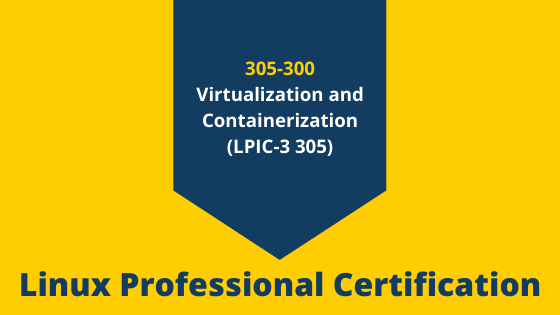LPI LPIC-3 Exam Summary:
| Exam Name | LPIC-3 Virtualization and Containerization |
| Exam Code | 305-300 |
| Exam Price | $200 (USD) |
| Duration | 90 Mins |
| Number of Questions | 60 |
| Passing Score | 500 / 800 |
| Sample Questions | LPI LPIC-3 Sample Questions |
| Practice Exam | LPI 305-300 Certification Practice Exam |
LPI 305-300 Exam Syllabus Topics:
| Topic | Details |
| Full Virtualization | |
| Virtualization Concepts and Theory |
Weight: 6 Description: Candidates should know and understand the general concepts, theory and terminology of virtualization. This includes Xen, QEMU and libvirt terminology. Key Knowledge Areas: ◉ Understand virtualization terminology The following is a partial list of the used files, terms and utilities: ◉ Hypervisor |
| Xen |
Weight: 3 Description: Candidates should be able to install, configure, maintain, migrate and troubleshoot Xen installations. The focus is on Xen version 4.x. Key Knowledge Areas: ◉ Understand architecture of Xen, including networking and storage The following is a partial list of the used files, terms and utilities: ◉ Domain0 (Dom0), DomainU (DomU) |
| QEMU |
Weight: 4 Description: Candidates should be able to install, configure, maintain, migrate and troubleshoot QEMU installations. Key Knowledge Areas: ◉ Understand the architecture of QEMU, including KVM, networking and storage The following is a partial list of the used files, terms and utilities: ◉ Kernel modules: kvm, kvm-intel and kvm-amd |
| Libvirt Virtual Machine Management |
Weight: 9 Description: Candidates should be able to manage virtualization hosts and virtual machines (‘libvirt domains’) using libvirt and related tools. Key Knowledge Areas: ◉ Understand the architecture of libvirt The following is a partial list of the used files, terms and utilities: ◉ libvirtd |
| Virtual Machine Disk Image Management |
Weight: 3 Description: Candidates should be able to manage virtual machines disk images. This includes converting disk images between various formats and hypervisors and accessing data stored within an image. Key Knowledge Areas: ◉ Understand features of various virtual disk image formats, such as raw images, qcow2 and VMDK The following is a partial list of the used files, terms and utilities: ◉ qemu-img |
| Container Virtualization | |
| Container Virtualization Concepts |
Weight: 7 Description: Candidates should understand the concept of container virtualization. This includes understanding the Linux components used to implement container virtualization as well as using standard Linux tools to troubleshoot these components. Key Knowledge Areas: ◉ Understand the concepts of system and application container The following is a partial list of the used files, terms and utilities: ◉ nsenter |
| LXC |
Weight: 6 Description: Candidates should be able to use system containers using LXC and LXD. The version of LXC covered is 3.0 or higher. Key Knowledge Areas: ◉ Understand the architecture of LXC and LXD Partial list of the used files, terms and utilities: ◉ lxd |
| Docker |
Weight: 9 Description: Candidate should be able to manage Docker nodes and Docker containers. This include understand the architecture of Docker as well as understanding how Docker interacts with the node’s Linux system. Key Knowledge Areas: ◉ Understand the architecture and components of Docker Partial list of the used files, terms and utilities: ◉ dockerd |
| Container Orchestration Platforms |
Weight: 3 Description: Candidates should understand the importance of container orchestration and the key concepts Docker Swarm and Kubernetes provide to implement container orchestration. Key Knowledge Areas: ◉ Understand the relevance of container orchestration |
| VM Deployment and Provisioning | |
| Cloud Management Tools |
Weight: 2 Description: Candidates should understand common offerings in public clouds and have basic feature knowledge of commonly available cloud management tools. Key Knowledge Areas: ◉ Understand common offerings in public clouds Partial list of the used files, terms and utilities: ◉ IaaS, PaaS, SaaS |
| Packer |
Weight: 2 Description: Candidates should be able to use Packer to create system images. This includes running Packer in various public and private cloud environments as well as building container images for LXC/LXD. Key Knowledge Areas: ◉ Understand the functionality and features of Packer Partial list of the used files, terms and utilities: ◉ packer |
| Vagrant |
Weight: 3 Description: Candidates should able to use cloud-init to configure virtual machines created from standardized images. This includes adjusting virtual machines to match their available hardware resources, specifically, disk space and volumes. Additionally, candidates should be able to configure instances to allow secure SSH logins and install a specific set of software packages. Furthermore, candidates should be able to create new system images with cloud-init support. Key Knowledge Areas: ◉ Understanding the features and concepts of cloud-init, including user-data, initializing and configuring cloud-init Partial list of the used files, terms and utilities: ◉ cloud-init |
| Vagrant |
weight: 3 Description: Candidate should be able to use Vagrant to manage virtual machines, including provisioning of the virtual machine. Key Knowledge Areas: ◉ Understand Vagrant architecture and concepts, including storage and networking Partial list of the used files, terms and utilities: ◉ vagrant |




0 comments:
Post a Comment